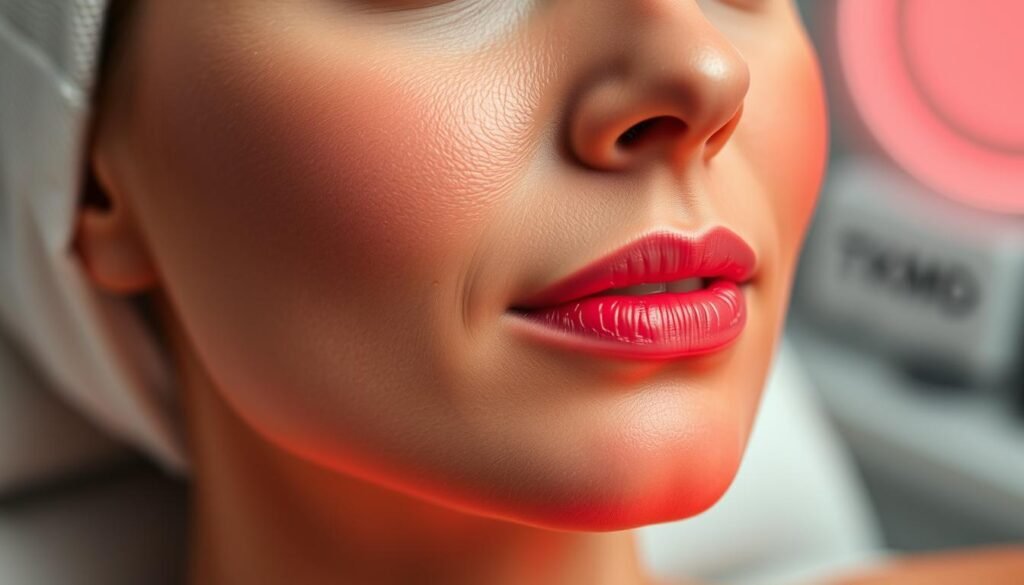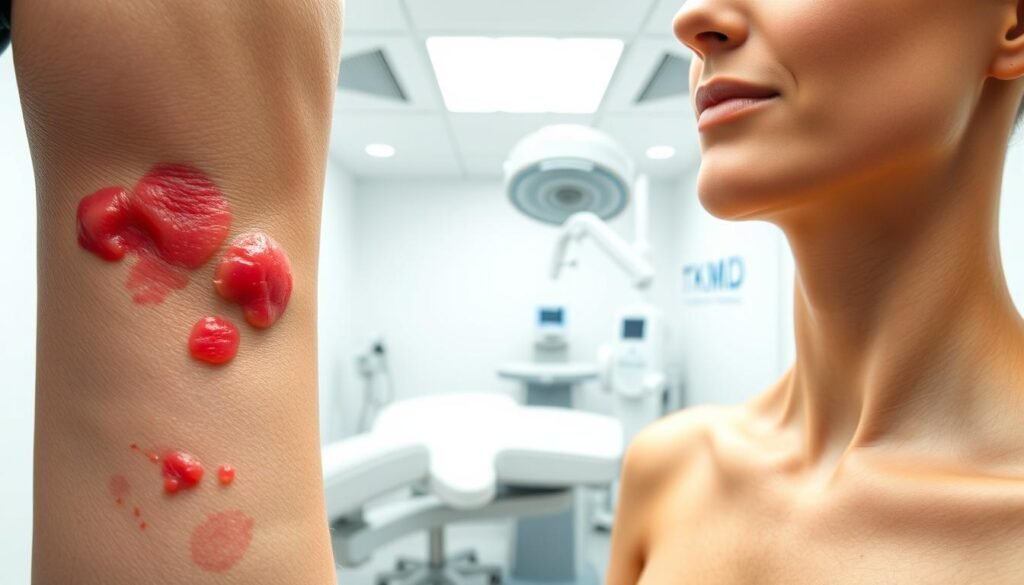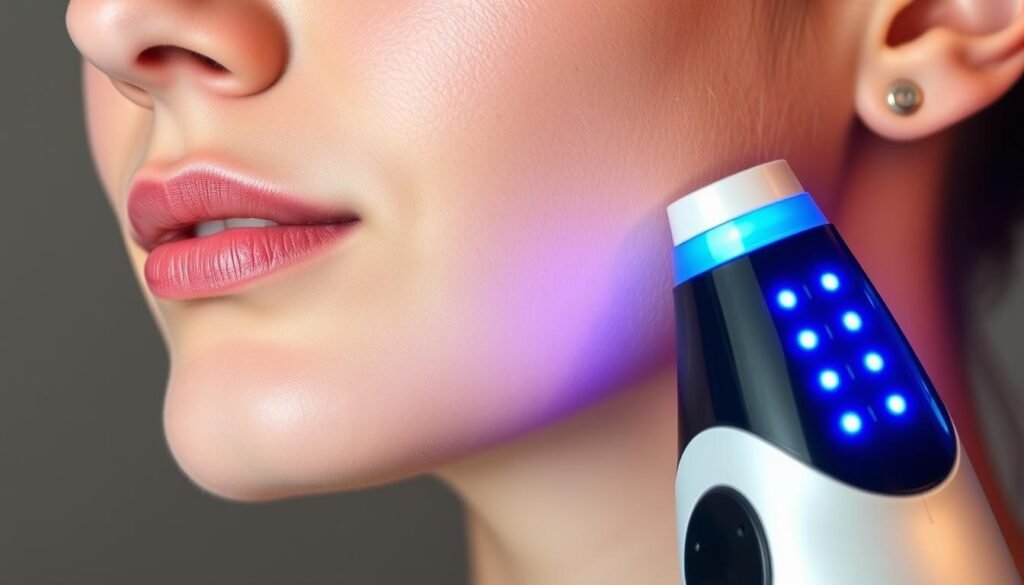Unwanted facial hair can be a persistent issue for many, affecting self-confidence and daily routines. Traditional methods like waxing, threading, or shaving offer temporary solutions, but laser hair removal has emerged as a modern, effective alternative.
This minimally invasive procedure targets hair follicles with concentrated light beams, damaging them to prevent future growth. It can be applied to various facial areas, including the upper lip, chin, cheeks, and sideburns, providing a longer-lasting solution compared to conventional methods.
Key Takeaways
- Laser hair removal is a popular, effective solution for unwanted facial hair.
- The procedure targets hair follicles to prevent future growth.
- It can be applied to various facial areas.
- Longer-lasting results compared to traditional hair removal methods.
- Minimally invasive with various benefits and considerations.
Understanding Laser Hair Removal for the Face
Facial hair removal through laser technology is gaining traction due to its effectiveness and long-term results. To understand how it works, it’s essential to delve into the specifics of the process.
What Is Laser Facial Hair Removal?
Laser facial hair removal is a non-invasive procedure that uses laser light to target and reduce unwanted facial hair. The process involves sending a light into the hair follicle via laser, which is absorbed by the pigment, or melanin, in the hair. This absorption converts the light into heat, damaging the hair follicle and impairing its ability to grow new hair.
How Laser Technology Targets Hair Follicles
The effectiveness of laser hair removal lies in its ability to selectively target hair follicles. The principle of selective photothermolysis allows lasers to target specific structures without damaging the surrounding tissue. Different laser wavelengths are designed to target different hair colors and types, making it possible to treat a wide range of hair colors. The heat generated by the laser damages the hair follicle, leading to a reduction in hair growth.
| Laser Wavelength | Hair Color | Effectiveness |
|---|---|---|
| 755nm (Alexandrite) | Dark hair | High |
| 800nm (Diode) | Dark to light brown hair | Medium to High |
| 1064nm (Nd:YAG) | Dark hair, suitable for darker skin tones | High |
Benefits of Laser Treatment for Facial Hair Removal
Laser treatment for facial hair removal offers numerous benefits, making it a popular choice for those seeking a more permanent solution. As stated by a renowned expert,
“Laser hair removal is a game-changer for individuals dealing with unwanted facial hair.”
This method not only reducesunwanted hairbut also provides a smoother skin texture.
Precision and Speed Advantages
Laser hair removal is highly precise, targeting specific areas without damaging the surrounding skin. This precision, combined with its speed, makes it an attractive option for those looking to remove facial hair efficiently. The procedure is relatively quick, with most sessions lasting between 15 to 60 minutes, depending on the area treated.
Long-Term Results Compared to Other Methods
Unlike temporary hair removal methods like shaving, waxing, or threading, laser hair removal provides long-term results. Most patients experience a significant reduction in hair growth after a series of sessions, with some achieving up to 90% permanent hair reduction. While it may not be completely permanent, the laser hair removal treatment offers a more lasting solution, reducing the need for frequent maintenance.
Ideal Candidates for Facial Laser Hair Removal
The effectiveness of laser hair removal on the face depends significantly on the individual’s skin type, hair color, and overall health condition.
Skin and Hair Types That Respond Best
Individuals with light skin and dark hair typically respond best to laser hair removal because the laser targets the pigment in the hair. However, advancements in laser technology have made it possible for people with different skin tones and hair colors to be treated effectively.
Medical Considerations and Contraindications
Certain medical conditions, such as active skin infections, open wounds, or specific skin cancers, may prevent someone from being a good candidate. Pregnant women are advised to avoid laser treatments as a precaution. Additionally, individuals on medications that increase photosensitivity, like certain antibiotics or retinoids, may need to postpone treatment. It’s crucial for candidates to disclose their medical history and any medications they’re taking to their practitioner.
Preparing for Your Laser Facial Hair Treatment
Before undergoing laser facial hair treatment, it’s crucial to prepare your skin for the procedure to ensure optimal results. Proper preparation involves several steps that help minimize potential risks and maximize the effectiveness of the treatment.
Pre-Treatment Guidelines
To prepare for your laser facial hair removal treatment, it’s essential to follow certain guidelines. If you have darker skin, your doctor may prescribe a skin bleaching cream to lighten your skin for the treatment. Avoid using sunless creams to darken your skin, as it’s crucial that your skin is as light as possible for the procedure. Shaving or trimming the area the day before your appointment is also recommended, as this helps the laser target the hair follicles more effectively.
What to Avoid Before Your Appointment
There are several products and activities to avoid before your laser facial hair removal appointment. To minimize the risk of complications, avoid using skincare products that contain retinoids, glycolic acids, and other exfoliating ingredients that may sensitize the skin. Chemical peels, microdermabrasion, and other intensive skin treatments should be avoided for at least weeks before the treatment. Additionally, self-tanners and bronzers should be completely avoided, as they can confuse the laser and potentially cause burns or hyperpigmentation. On the day of the procedure, refrain from applying makeup, lotions, and deodorants to the treatment area. It’s also advisable to limit alcohol consumption 24-48 hours before treatment and wear loose, comfortable clothing to your appointment.
The Laser Hair Removal Procedure Step by Step
The process of laser hair removal is straightforward and has been refined over the years to maximize efficacy and minimize discomfort. It involves the use of laser technology to target and reduce unwanted facial hair.
What Happens During a Facial Treatment Session
During a facial laser hair removal session, a practitioner uses a laser device to emit light that targets the hair follicles. The sensation is often compared to a rubber band snapping against the skin or a warm pinprick. The treatment area is typically cleaned and prepared beforehand, and protective eyewear is worn by both the practitioner and the patient.
Pain Level and Comfort Measures
While some discomfort is possible during laser hair removal, it’s often described as manageable and less painful than other hair removal methods like waxing or threading. The pain level can vary depending on individual pain tolerance and the area being treated. To enhance comfort, practitioners may use topical numbing creams, cooling devices, or cooling gels. Some patients also find that the sensation is comparable to a rubber band snap, but this is typically brief and only occurs during the procedure.
As stated by a patient, “
I’ve had my fair share of waxing, but laser hair removal is a game-changer. The discomfort is minimal compared to the long-term results.
“
Targeted Facial Areas for Laser Hair Removal
Laser hair removal offers a precise solution for removing unwanted hair from various facial areas, enhancing overall appearance and confidence.
Upper Lip and Chin Treatment
The upper lip and chin are common areas for laser hair removal on the face. These regions often require precise treatment to address coarse or dark hairs. A skilled practitioner will carefully target these areas to achieve smooth results. For more information on effective laser hair removal, visit Ethereal Skin MedSpa.
Cheeks, Sideburns, and Other Facial Regions
Laser hair removal can effectively address hair on the cheeks, sideburns, and other facial regions. The cheeks, in particular, can be challenging due to finer hairs, but laser technology can target these areas effectively. Sideburn treatments require careful delineation to maintain natural-looking hairline boundaries. 
Post-Treatment Care and Recovery
Effective post-treatment care is key to achieving the best possible outcomes from laser hair removal treatments. Proper aftercare not only enhances the results but also minimizes potential side effects.
Immediate Aftercare Instructions
The area treated may be sensitive after the procedure. It’s crucial to follow immediate aftercare instructions to ensure a smooth recovery. Avoid direct sun exposure, and apply gentle, non-irritating products to soothe the skin.
- Avoid plucking or waxing between sessions.
- Use gentle skincare products.
- Monitor the treated area for unusual reactions.
Long-Term Skin Protection Between Sessions
To maintain the effectiveness of the treatment and protect your skin, diligent sun protection is necessary. Apply broad-spectrum SPF30+ sunscreen daily to all treated facial areas, and consider physical sun protection like wide-brimmed hats when outdoors.
- Apply broad-spectrum SPF30+ sunscreen daily.
- Use physical sun protection.
- Schedule subsequent treatments as recommended.
Potential Side Effects and Risks
Before undergoing laser facial hair removal, it’s essential to understand the possible side effects and risks involved. While the procedure is generally safe, there are potential complications to be aware of.
Common Temporary Reactions
Temporary reactions to laser facial hair removal can include redness, swelling, and mild discomfort. These reactions are usually short-lived and resolve on their own within a few hours to a few days. Some individuals may experience skin irritation or ingrown hairs, but these effects are typically temporary.
Rare Complications and How to Avoid Them
Rare but possible complications from facial laser hair removal include blistering, scarring, burns, or infection. Paradoxical hypertrichosis, or increased hair growth in or around treated areas, is another rare side effect that can occur. To minimize risks, it’s crucial to choose a qualified practitioner and follow all pre-treatment and post-treatment instructions precisely.
| Complication | Description | Prevention |
|---|---|---|
| Blistering | Rare, more likely in darker skin types | Proper laser setting, cooling measures |
| Scarring | Extremely rare with proper protocols | Choosing a qualified practitioner |
| Infection | Rare, can occur with poor aftercare | Following post-treatment instructions |

Treatment Timeline and Expected Results
Achieving optimal results with laser facial hair removal requires a series of treatments, and the outcome can vary from person to person. The effectiveness of the treatment is influenced by several factors, including individual hair growth patterns and the number of sessions undertaken.
Number of Sessions Needed for Optimal Results
Most patients experience 70-90% permanent hair reduction after completing their full treatment course, which typically consists of multiple sessions. The exact number of sessions required can vary depending on factors such as skin type, hair color, and the area being treated.
Maintenance Requirements After Completion
While laser hair removal provides long-lasting results, it’s not always 100% permanent for everyone, particularly in facial areas influenced by hormones. Many patients benefit from annual touch-up treatments to manage any minimal regrowth. Hormonal changes can stimulate new hair growth, potentially necessitating additional sessions.
The results of laser hair removal can last from several months to several years, depending on maintenance. Any new hair growth that occurs after treatment completion is typically finer, lighter, and less noticeable than the original hair.
| Treatment Stage | Expected Outcome | Maintenance Needs |
|---|---|---|
| After 1-3 Sessions | Noticeable reduction in hair growth | Minimal maintenance required |
| After 4-6 Sessions | 70-90% permanent hair reduction | Annual touch-ups may be needed |
| Post-Treatment | Long-term hair reduction | Periodic maintenance sessions |
Maintaining hormonal balance through appropriate medical care can help extend results for those whose facial hair is hormonally influenced. It’s essential to evaluate the amount and type of regrowth to determine when a maintenance session might be needed.
Cost of Laser Treatment for Facial Hair Removal
When considering laser facial hair removal, cost is an essential factor to evaluate. The overall expense can be influenced by several variables, making it important to understand what affects the pricing.
Average Price Range and Factors Affecting Cost
The cost of laser facial hair removal can vary significantly based on factors such as the size of the treatment area, the number of sessions required, and the technology used. On average, the price per session can range widely. It’s also important to consider that larger areas or more dense hair growth may require more treatments, thereby increasing the total cost.
Insurance Considerations and Payment Options
Since laser hair removal is typically considered a cosmetic procedure, it is generally not covered by health insurance. However, there may be exceptions for certain medical conditions that cause excessive hair growth. Various payment options are available, including healthcare credit cards like CareCredit, in-house payment plans, and healthcare savings accounts. Many providers also offer financing options that allow patients to spread the cost over several months. It’s advisable to inquire about price-matching policies and to request a detailed written quote before beginning treatment.

Conclusion: Is Laser Facial Hair Removal Right for You?
As we’ve explored the benefits and process of laser hair removal, it’s clear that this treatment offers a revolutionary solution for those tired of traditional hair removal methods. Laser hair removal may be ideal for individuals seeking long-lasting results and precision. While it requires an initial investment, it offers significant long-term savings. To ensure safe and effective treatment, make sure to choose qualified practitioners.
Before undergoing hair removal treatment, consider your skin type, hair color, and medical history. Laser hair removal may not be suitable for everyone, particularly those with certain medical conditions. Advances in laser technology continue to make treatments more comfortable and effective for a wider range of skin tones and hair colors.


